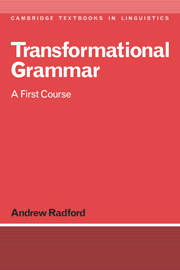3 - Phrase-markers
Published online by Cambridge University Press: 05 June 2012
Summary
Overview
In the previous chapter, we argued that sentences are not just unstructured sequences of sounds; rather, they have a hierarchical constituent structure in which sounds are grouped together into words, words into phrases, and phrases into sentences. Each constituent (word or phrase) in a sentence belongs to a specific syntactic category. The categorial constituent structure of sentences can be represented in the form of a Phrase-marker, in which the different nodes are labelled according to the category of the constituent they represent. But what are Phrase-markers? What kind of rules might we devise to generate (i.e. tell us how to form) Phrase-markers? And what exactly is the nature of the categories which are used to label the various constituents which Phrase-markers contain? These are the three essential questions which we address in this chapter.
The nature of Phrase-markers
In the previous chapter, we used Phrase-markers to represent the constituent structure of sentences. But what exactly is a Phrase-marker? It's useful to think about this problem for a while, and to devise some appropriate technical terminology for describing the internal structure of P-markers, since this will turn out to be of vital importance in subsequent chapters. But why do we need technical jargon? Well, any adequate description of any phenomenon in any field of enquiry (in our present case, Syntax) must be maximally explicit, and to be explicit, it must be formal – i.e. make use only of theoretical constructs which have definable formal properties.
Information
- Type
- Chapter
- Information
- Transformational GrammarA First Course, pp. 109 - 166Publisher: Cambridge University PressPrint publication year: 1988
